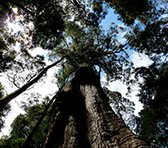1 December 2015
Branching Out: Composing a Musical Tree

I struggle with titles. Finding the perfect word or phrase to represent one's work is daunting. Sometimes, it can prove more challenging than writing the music. In some rare cases, I'll know from the very beginning what the title is going be. And in the case of my most recent composition, the title was the inspiration.
I came across the word 'arborescence' while reading about 20th-century Greek-expat composer Iannis Xenakis. While our sound worlds are entirely different, I feel a strong sympathy with his artistic convictions, and his ideas about space, structure and architecture.
'Arborescence' means treelike, in growth or appearance. Xenakis used it to describe a kind of generative process in his composing. Essentially, he'd begin with single melodic lines, then would reiterate their contour by producing multiple melodic offshoots: a kind of musical 'branching out'.
I began developing ideas for what the soundworld of a piece about trees might be like, and then approached Syzygy Ensemble about writing the work for them. Syzygy is an amazing Melbourne-based new-music group, made up of flute, clarinet, violin, cello and piano. This diversity and economy of instrumentation is attractive to me. And they're the most wonderful people. I asked, and they agreed.
I wrote the piece in a relatively short period of time. And while I don't always write in a linear way, for some reason composing from the start to the end of this piece seemed like the right way to go. I made some adjustments after a development session with the ensemble a few months ago. And much of the process was also aided by mentoring sessions with Brenton Broadstock. I'm very thankful for his insights and advice during the process.
I was exploring a number of natural growth processes when developing ideas for the piece. One such process was the 'fractal' idea: structural patterns recurring throughout nature, like in certain leaves and flowers, where the shape of the whole is represented in its constituent parts. I adopted a loose interpretation of this, by creating sinuous melodic shapes that could be reiterated and adapted to form the larger structure of the piece.
As the individual melodies develop through branching, so, too, did the large-scale structure of the piece. I devised two main sections, divided by a musical 'trunk'. The first begins in darkness, being restricted to mostly bass register pitches. This is representative of a tree's root systems beneath the earth. The second half of the work then is composed almost entirely in the treble register, and evokes the top part of a tree reaching into the air.
The first thing I developed was the basic thematic and sonic materials of the work. To extend the nature metaphor further, I created a kind of motivic snapshot, or 'seed', which I present at the beginning of the piece. This 'seed' contains the primary pitch and gestural material developed throughout the piece.
The next thing I wrote was the primary root of my tree: an extended cello solo that grew out of the seed motive, and some of my own mucking about on the cello. I wanted to capture a root's twisted, gnarled character, so I developed a range of timbral inflections and distortions on the cello that in my mind could suggest a tree root buried deep beneath the earth.
I then developed a sort of subterranean musical atmosphere to accompany the cello solo. The other instruments of the quintet begin by echoing the timbral gestures of the cello solo, before they eventually becoming participants in a tangled network of melodies evoking a complex root system.
The knotted, discordant polyphony that results reaches a climax towards the middle of the work, at which point a violent grinding of chords is triggered. This is my tree's 'trunk'. This part posed some challenges during the composition process: how could I musically depict something so strong and powerful, but which is arguably the least dynamic part of the tree?
This chordal sequence I developed seemed to suggest the 'coming together' of a tree's trunk (as opposed to the multiplicity of the roots below). I have instruments in the ensemble change pitch at different rates, creating a sort of slow churning, though highly energised, musical interplay - as if the tree is violently trying to break through to the world above.
Then, when composing the top half of my tree, I recast the opening 'underground' music in the treble register, also giving it a new harmonic identity. The cello solo became a clarinet solo, and the dark, seething, snarling polyphony of tree roots became an open, ecstatic song, which sounds almost like an aviary.
Unwittingly, my tree had become filled with birdlife. So to finish, I decided those birds would fly away, with the trilling, chirruping music dissipating, to leave only a few, high-pitched melodies to linger - like a few lone leaves trembling on the top-most twigs of a tree.
Event details
Syzygy Ensemble - Gaia
Melbourne Recital Centre, Wednesday 2 December at 6pm
Works by Andrew Aronowicz, Brenton Broadstock, Jonathan Harvey
and Isang Yun
Full event details: AMC Calendar
Further links
Andrew
Aronowicz - homepage
Syzygy
Ensemble - homepage
© Australian Music Centre (2015) — Permission must be obtained from the AMC if you wish to reproduce this article either online or in print.
Andrew Aronowicz is a Melbourne-based composer, teacher and writer.
Comments
Be the first to share add your thoughts and opinions in response to this article.
You must login to post a comment.